Franconian cuisine
Food and drink is a topic in Franconia as well as in Upper Franconia, Lower Franconia, Middle Franconia at any time. Franconian cuisine emphasizes meat and potatoes, as for example the best known specialties are Bratwürste and Schäufele with potato dumplings. Brotzeit is also highly valued. Despite some overlaps, it differs from Bavarian cuisine.
Understand
Upper Franconia holds 3 culinary records: In Upper Franconia, there are 2,080 inhabitants per bakery or pastry shop, 1,540 inhabitants per butcher shop and 5,511 per brewery.
Bratwursts
The Bratwursts in Coburg are the largest with at least 31 cm, the coarse fullness in the pig intestine is usually roasted over the open pine cone fire, which gives the special aroma. It is also the only one that is eaten singly, all other Upper Franconian varieties can be enjoyed in pairs or more.
Just as coarse, but smaller, are the fried sausages in the Forchheim area, medium-coarse in the area of Bamberg, Lichtenfels and Kronach. A speciality in Kronach are the G'strüpften, they are cut open, skinned and baked, not fried.
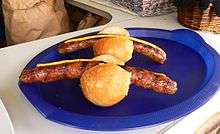 Coburg Bratwurst
Coburg Bratwurst- Bamberg Bratwurst
Fine fried sausages, rather long and thin, can be found in the areas around Hof, Bayreuth and Kulmbach.
The Hof Bratwurst is made from lean pork and some beef. It is cut very finely with the addition of ice cubes, and then about 50 grams of sausage meat is filled into a pork gut with a diameter of 18-22 mm. It is usually sold and eaten in pairs.
The Kulmbach Bratwursts are very similar to those in Hof in appearance but are produced with a high veal content. They are served at the Bratwurst stand in the Bratwurst Stollen, an elongated roll with lots of aniseed. You order either two bratwursts in half a bratwurst stollen or three sausages in a whole stollen.
- two bratwursts in half a bratwurst stollen
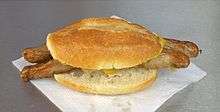 A pair of Bayreuth bratwursts
A pair of Bayreuth bratwursts- Fried sausages from Hof with sauerkraut and mashed potatoes
The Pegnitz Bierbratwurst contains 20 % to 25 % beer, depending on the alcohol content of the beer.
The Würzburg Bratwurst, also called Winzerbratwurst (winemaker bratwurst), contains a dash of Franconian white wine.
The longest Bratwursts are in Sulzfeld am Main, the place is known for the Meterbratwurst (the spiral on the plate is 1 meter long). Today it is offered in five inns, in the "Ratsstube", in the "Michels-Keller", "Zum Hirschen", "Zum goldenen Löwen", and in the inn "Zum Stern". Everywhere it tastes a bit different, everyone prepares it according to their own recipe, one would have to try it out to find the best.
The Altmühl Bratwurst in southern Franconia is the coarsest of its kind. The special distinguishing feature is the ribbon (epidermis/serosa of the pig's small intestine), which makes it visually distinguishable from most other sausages. It is about ten to 12 centimeters long and weighs about 80 to 100 grams, it is not turned off like others, but only slightly expressed at the ends and then closed by turning over the ends of the intestines.
Nuremberg Bratwursts they are shortest with a length of 7 to 9 cm. It is typically eaten in a dozen (12) or half a dozen (6) or as the smallest unit Drei im Weggla (three in a roll).
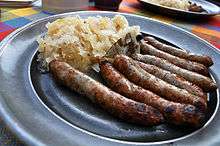 Nuremberg bratwursts
Nuremberg bratwursts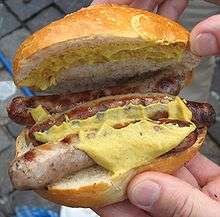 Drei im Weggla
Drei im Weggla
- nuernberger-bratwuerste.de - die-nuernberger-bratwurst.de - Information about the Nuremberg Bratwurst.
In the pub you can get the sausages mostly fried with sauerkraut. However, there is also the variant cooked in onion stock, called Blaue Zipfel or Blaugsottene.
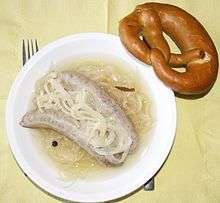 Blaue Zipfel or Blaugsottene
Blaue Zipfel or Blaugsottene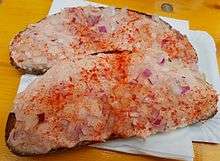 Ausgstraaftaa
Ausgstraaftaa
With mustard or without mustard (Senf), or rather with horseradish, everyone has to decide for himself. As there are still many smaller and local horseradish and mustard producers in Franconia (especially in the horseradish region around Baiersdorf and Aischgrund), you can choose and find your own favourite variety, for example 🌍 "Siebenstern-Senf" from Oberkotzau or "Fuchs-Senf" from Röttenbach.
The filling of the sausages, the Bratwurstbrät, is often spread on bread, sprinkled with diced onions and seasoned with salt, pepper or paprika. There are many names for it, e.g. Ghäckbrot or Ghacktsbrot (from minced) or in Upper Franconia also Ausgstraaftaa (striped).
The Bratwurst summit has been taking place in Pegnitz for several years now. Every year on the Sunday before Whitsun four butcher's shops from Lower, Upper and Middle Franconia meet to compete. Prizes are awarded in the disciplines classical Franconian bratwurst or most creative bratwurst.
Roast
In Franconia there are potato dumplings for roasting (Gliis, Glees, Glus, Gniedli), not like in the south of Bavaria bread dumplings. Wheat for light bread is hardly grown, mostly barley was grown for brewing. But the potato was undemanding and also grew well in the Fichtelgebirge. Thus a potato tradition developed in Franconia, as well as in nearby Thuringia.
Below only a small selection of dishes. Those who stroll through Franconian inns will discover a variety of dishes that are also worth mentioning.
Schwein
- Schäufele. is the shoulder blade of the pig. The meat is cooked completely with the shoulder blade bone and the fat rind in the oven. A dark gravy and potato dumplings are served. As a side dish there is either a salad plate, or in Upper Franconia also sauerkraut or red cabbage. The dish is so popular that there is even a club Freunde des Fränkischen Schäufele.
- Haxn', Schweinshaxe, Knöchla (knuckle of pork) is the part of the pork leg between the knee or elbow joint and the tarsal joints. Haxn are grilled with sauerkraut, cooked with horseradish sauce, or served as pepper knuckles breaded with pepper sauce.
- Rippla (ribs) are braised in the oven and served with dumplings and often with sauerkraut. Or also in Lower Franconia as Ribb'le with Graud, similar to a Kassler rib, served with sauerkraut.
- Schäufele with crispy crust
- Breaded pepper knuckle with pepper sauce and dumplings
- Ribs with dumplings
- Schwarzfleisch mit Bohnakern (Black meat with beans), black meat (smoked meat) is cooked and then smoked ham or pork belly. The meat is often served with beans and dumplings cooked for hours.
- Sauerbraten is a traditional sweet and sour stew with different regional variations. Raw meat, mostly beef, is pretreated by marinating it in a vinegar marinade for several days. In earlier times, sour marinade was used to protect meat from spoilage. The meat is then sautéed, infused with diluted marinade and braised for several hours. The meat is then sweetened to obtain the typical sweet and sour taste of the sauce and thickened with gingerbread sauce. The piece of meat is cut into slices and served with potato dumplings, boiled potatoes or noodles, usually served with red cabbage.
- The Schwarze Sauerbraten in the Coburg area is prepared with black smoked meat and served with dumplings. Smoked pork comb or smoked pork ham is often used for preparation.
- With the Bamberger Zwiebel a large onion is hollowed out, filled and then braised in a beer sauce. The raw and smoked pork belly is turned through the wolf, or minced meat or sausage meat is used as filling, then mixed with rolls and eggs and stuffed into the onion. Before serving, add a crispy fried slice of bacon and garnish with mashed potatoes or sauerkraut. The stuffed onion is also known outside Bamberg, e.g. as Kulmbach beer onion in the Kommunbräu.
- Krautwickel (cabbage rolls) are blanched savoy cabbage or white cabbage leaves which are then coated with meat mass and wrapped. Different side dishes with sauce are served.
- Bamberger Zwiebel
- Krautwickel with potato salad
Beef
- The Franconian Sauerbraten is in contrast to the Rhineland Sauerbraten without raisins and also not from the horse. A Sauerbraten is a braised roast whose meat is pre-treated by marinating it in vinegar water with spices for several days. The sauce is bound with a sauce cake, which gives the Sauerbraten its own note. Dumplings and red cabbage are often served as a side dish.
- Rouladen (Roulades) are thin slices of meat, usually beef or veal, spread with mustard, stuffed, rolled up and braised. Typical is a filling with bacon, cucumber and onions.
- Krenfleisch is a typical Kirchweih (church fair) dish. It is boiled beef with a horseradish sauce served with dumplings.
- Rinderschmorbraten - braised beef
- Beef roulade with red cabbage and bread pudding and potato dumplings
- Beef leg slice with dumplings
- Rinderzunge (cattle tongue) with Madeira sauce and dumplings is often on Sunday menus.
- Beef tongue in Madeira sauce
Poultry
- Ducks or geese are usually on the menus during the cold season. Often the breast is served, but also the thighs or halved or quartered animals are served on the plate. Dumplings and red cabbage are common side dishes.
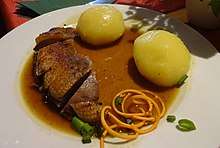 goose breast with dumpling
goose breast with dumpling- duck leg
Sheep and goat
- Lammbraten (roast lamb) of native lambs is offered from the Franconian Switzerland to the Rhön.
- In the Haßberge and Steigerwald the Bocksbraten (Roast goat) is a popular dish with the Kerwa (church fair), mostly in late summer and autumn. It uses the meat of adult goats, or roast pieces of goat. Contrary to the popular opinion that the meat of adult animals cannot be used any more because of the strict smell and taste of the goat, the taste of the goat is not so prior. Similar to sauerbraten, the meat is marinated in vinegar for several days before preparation. The cooked meat is served with a blood sauce and dumplings.
- Lamb knuckle with dumpling
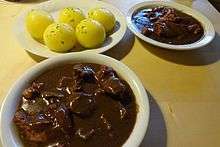 Roast goat with dumplings
Roast goat with dumplings
Game
During the hunting season in autumn there are regular dishes of wild rabbit, roe deer, deer and wild boar on the menus. Game hares and poultry are less common. The game is usually offered as roast, more seldom than short roasted. Some restaurants also offer sausages, ham or salami.
- Larded roast venison with dumpling
- Wild hare leg with dumpling and red cabbage
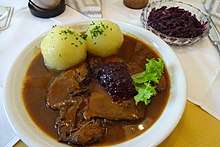 roast wild boar
roast wild boar
Dumplings
When you travel through Franconia, you quickly notice how many variations of dumplings are prepared. They are made from raw or cooked potatoes, or a mixture of both. Nowadays dumpling doughs are offered by the industry, but in many inns in Franconia, however, the dumplings are still prepared completely by themselves, one tastes the difference.
Eine Spezialität in der Gegend von Coburg sind die Coburger Klöße. Dies sind Kartoffelklöße, die zur Hälfte aus rohen (wie die Thüringer) und aus gekochten Kartoffeln (wie die Fränkischen) hergestellt werden. Im Inneren werden sie mit gerösteten Brötchen- oder Weißbrotwürfeln (Bröckla) gefüllt.
- In the 🌍 Coburger Kloßküche there is dumpling dough to take away, if you have a pot with you, you can take ready dumplings with you. Dumplings with roasts can also be eaten right there.
- One weekend at the end of August there is a dumpling market in Coburg. Everything revolves around the Coburg dumpling, also known as the "Coburg Rutscher". There are various roasts with the appropriate sauces to the dumplings.
- Serviettenkloß - Pudding made from old rolls, milk and egg, cooked in a dishcloth.
- Potato dumplings filled with toasted white bread dices
- fried dumplings with egg and diced sausage
Sometimes Semmelklöße are on the menu. They differ from the Bavarian bread dumplings (Semmelknödeln) in that they are much larger, they are often cooked in a tea towel (Serviettenkloß) and cut into slices for serving.
Eingeschnittene Klöße, also called Eigschnittna or Röstklöße, are the remaining potato dumplings from the day before, which are fried in slices. The dish is offered in many combinations, for example with ham, egg and salad or with leftovers and gravy. The rest of the Sunday dumplings are often served in the inns on Monday.
Flour dumplings
Mehlklöße (flour dumplings) are a side dish, or their own dish, which one finds mainly in Lower Franconia, but is also eaten in the other parts. In Rhön they are called Mahlklüss, in Bamberg they are called Schbodsn. The dough for them is made of flour, eggs and some salt, often semolina, or diced potatoes or rolls are added to the dough. The dumplings are boiled in salted water and then usually fried in a pan. Fresh flour dumplings are served as a side dish to roast pork or roulades, but are also eaten with preserved fruit such as pears as a dessert. It is also common to eat them with cucumber salad as an independent dish. In summer they are served with lettuce, in winter with sauerkraut and a piece of meat. The remaining flour dumplings are cut into small pieces and fried, often eggs are added. This type of dumpling is called Klößbrocken or eingeschnittene Klöß. There are many ways to make flour dumplings and even more to bring them to the table.
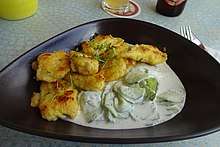 Flour dumplings with cucumber salad
Flour dumplings with cucumber salad
Sauces
It is important for the dumplings that there is always enough sauce on the plate.
- Franconians love creamy sauces, which are tied with sauce gingerbread with sauerbraten and game dishes. More information can be obtained from the gingerbread manufactory Leupoldt. You can buy them in Franconia in almost every supermarket.
- Horseradish sauce is mostly horseradish, broth and cream. It is bound with breadcrumbs or a white roux. The degree of sharpness varies depending on the guesthouse. The sauce is often served with cooked beef, but also with different parts from pork to cooked knuckle of pork.
- Beef with horseradishsauce with dumplings
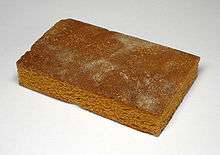 Soßenlebkuchen - gingerbread for sauces
Soßenlebkuchen - gingerbread for sauces
Side dishes
- Red cabbage or sauerkraut are often served as a side dish.
- Savoy cabbage turned through the mincer and refined with cream is often served for roasts with dumplings.
- To lamb dishes and smoked meat there are also beans or sour beans with a vinegar roux.
- Rübenkraut is the name given to autumn turnips which, like sauerkraut, have been preserved by lactic fermentation.
- 🌍 Brewery Hennemann In the brewery Hennemann in Pommersfelden there is turnip greens from October to spring.
- Baggers is the Franconian name for potato pancakes.
- Red cabbage as a side dish with roast meat
- Chopped savoy cabbage with cream
- Beans with a sour roux
- beans
- G´stopfta Rumm is a specialty only available in Wallenfels. Only in the winter half-year there is the easily sour side dish to poultry or pork courts. After the harvest time in October, November the ingredients are chopped up into barley grain-size particles and afterwards in layers into a barrel are given, salted and stuffed. After the fermentation period of several days, the "Gschpotften Rumm" are fermented like sauerkraut and can be processed further. The mixture consists of field turnips, savoy cabbage, white cabbage, yellow turnip and leek. In the Egersmühle and Roseneck inns, you can try the rum until about Easter. It is also possible to take a double portion home with you.
Other dishes
The popular three-course Fränkische Festtagsessen consists of the starter as a soup of beef broth with marrow dumplings (liver dumplings) and/or semolina dumplings, as a main course of beef cooked in soup vegetables (boiled beef: the pointed, tender tail piece of beef) and in addition absolutely a horseradish sauce. Main course side dishes are usually broad noodles and cranberries or, as a variation, parsley potatoes and beetroot. A dessert belongs to it, a firm rule does not give it here.
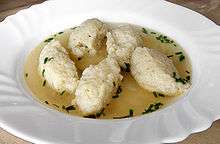 Semolina dumpling soup as starter
Semolina dumpling soup as starter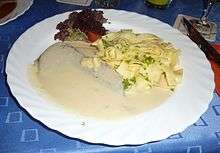 Boiled beef with horseradish sauce as main course
Boiled beef with horseradish sauce as main course
Lakefleisch (brine meat), also called Köhlerfleisch, has its origin in Spessart. In earlier times, workers who worked wood in the forest wrapped their brine meat in newspaper and put it in the embers. It is pork that is preserved in brine, hence the name, for a long time. The meat is then wrapped in aluminium foil with onions and spices and originally cooked in the embers or more modernly in the oven. Today there are still several butcher's shops and restaurants that maintain the long tradition of brine meat.
The Zwiebelblootz resembles the Alsatian Flammkuchen. It consists of a yeast dough with a layer of steamed onion rings, bacon and ham and is covered with a mixture of eggs and cream and then baked in the oven.
Schlachtschüssel - Pig slaughter festival
Different cooked parts of the pig are called Schüpf, Schipf, Spund or Schlachtschüssel. These include belly meat, head meat, kidney, heart and liver, rarely tongue or pig's head. The various pieces are served with sauerkraut, bread or potatoes.
"Wellfleisch" is cooked, uncured pork belly meat. It is often eaten with sauerkraut and dumpling, but also hot or cold with horseradish and bread.
Franconian "Siedwürste" are available in red as blood sausages and white as liver sausages. They are served warm with sauerkraut and bread, potatoes or fried potatoes or are part of the Schlachtschüssel. In the past, slaughtering was almost exclusively done during the cold season because of the refrigeration, and even today the dishes are only on the menu from autumn to spring.
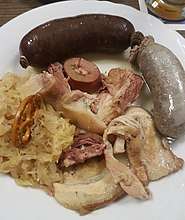 Schlachtschüssel with siedwursts, kidney and belly meat
Schlachtschüssel with siedwursts, kidney and belly meat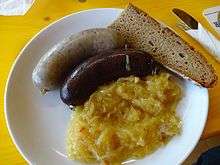 Siedwursts with sauerkraut
Siedwursts with sauerkraut- Wellfleisch with sauerkraut and dumpling
The diaphragm is referred to in the kitchen as Kronfleisch. In the Fichtelgebirge, the coarse-fibrous, dry muscle meat, mostly beef, is often eaten with bread, herb butter and horseradish. Under the name Kesselfleisch or Schüpf one finds Kronfleisch also in other Upper Franconian regions in the context of the schlachtschüssel. Innkeepers in the villages of Arzberg, Thierstein, Thiersheim, Hohenberg an der Eger, Höchstädt im Fichtelgebirge and Schirnding have joined forces and regularly offer Kronfleisch meals.
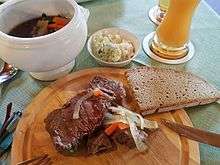 Kronfleisch in root stock. Garlic butter, grated horseradish and chopped onions are served with bread. The Kronfleisch can be ordered medium or drawn through. The root broth is spooned at the end.
Kronfleisch in root stock. Garlic butter, grated horseradish and chopped onions are served with bread. The Kronfleisch can be ordered medium or drawn through. The root broth is spooned at the end.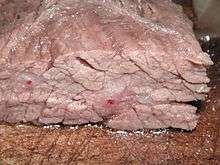 Kronfleisch in detail
Kronfleisch in detail
In the Bamberg area the sausage soup, from the freshly slaughtered pig, is called a kind of blood soup as Stechbrühe. It is served with dumplings on days when the Schlachtschüssel is offered.
The Schweinfurter Schlachtschüssel is customs in Schweinfurt and surroundings. The unusual thing about the Schweinfurt Schlachtschüssel is that it is not eaten as usual from plates, but from long wooden boards directly on the table. It cannot be found on any menu, but must be ordered in advance. A minimum number of eaters is required. The process is often carried out according to traditional rituals. Different parts of the pork are cooked and served in seven courses. The usual order is: belly meat - prick - bow - comb - head meat with tongue, ear and trunk - heart and other innards - kidneys. The pieces of meat are served directly in the middle of the table. Cold pieces and leftovers are simply put back in the middle of the table and removed from the table after each course. Only sauerkraut, salt, pepper, kreen and farmhouse bread are eaten with the meat and Franconian wine is drunk with it.
- The prepared table
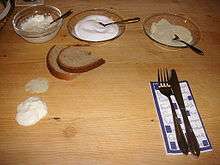 salt, pepper, horseradish and bread
salt, pepper, horseradish and bread- it's eaten off the plank.
Dishes with blood
Gebackenes Blut, (Baked blood), also called Schwaaß, is especially in the Hof still a popular, traditional dish. Similar to blood sausage or press sack, the blood of the slaughtered animal is filled with diced bacon, onions and old baked rolls, seasoned with marjoram and salt and baked. Traditionally, sauerkraut and potatoes or mashed potatoes are eaten as side dishes. In the Hofer Land, Frankenwald and Fichtelgebirge this dish is still offered by some inns on special days. There are also butchers who inform their customers about the dates when they can buy baked blood.
- 🌍 Gasthaus "Zur Hulda", Tiefengrüner Str. 1, 95180 Berg (Oberfranken)- Tiefengrün, ☎ +49 9293 637. Open daily from 11.00 a.m., Sundays from 9.00 a.m., Monday is rest day, except if Monday is a holiday, then Tuesday is closed.. There's still regular baked blood here.
For the Kirchweih (Church fair) in some pubs still Entenjung is prepared with blood sauce. Around November 11th there is often Gansjung in the inns, where parts of the Martin geese are processed. It usually consists of heart, stomach, wings, neck, head and feet of a goose (or duck, then it is Entenjung), which are first cooked and then served with a creamy blood sauce and dumplings.
- Baked blood with sauerkraut and potatoes
- Entenjung
- Gansjung
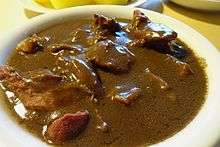 Roast goat, see above
Roast goat, see above
Blood sausages
- Red Franconian Siedwürste are soft blood sausages (see Schlachtschüssel). They are served warm with sauerkraut and bread, potatoes or fried potatoes or as part of the Schlachtschüssel. In some butcher's shops you can get smoked sausages at any time.
- Griefenwurst is a firm blood sausage from Lower Franconia, which is e.g. served with sour potato vegetables, or sold in a tin.
- Franconian Speckwurst is a cooked sausage made of pork blood, bacon, rind and spices. The basic mass is filled into wreath casings and smoked cold. It is often sold in rings, is durable and suitable as a souvenir.
 Siedwursts with sauerkraut
Siedwursts with sauerkraut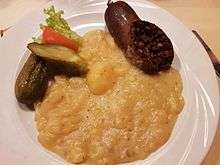 Griefenwurst with sour mashed potatoes
Griefenwurst with sour mashed potatoes- Speckwurst
Offal
- Saure Innereien, (sour innards) are cooked with vinegar or a wine sauce and then bound with a dark roux. The innards must be precooked for a long time to obtain a soft bite. Dumplings or mashed potatoes are often served as a side dish.
- 🌍 Brauerei Greifenklau, Laurenziplatz 20, 96049 Bamberg, ☎ +49 951 53219. Tuesday to Saturday 10.30 - 23.30 , Sunday 10.00 - 14.00, Monday rest day.
- G'schling is a culinary delicacy in Upper Franconia and the nearby Upper Palatinate. Lung, heart, kidneys and beef tongue are boiled down in a roux. Usually a roll or bread is eaten with it.
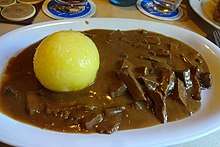 Sour beef heart with dumpling
Sour beef heart with dumpling
Vegetarian dishes
Vegetarians and vegans do not have it easy with the traditional Franconian kitchen. Today, however, vegetarian dishes can be found on almost every menu. Vegan dishes are still rare. If you are not a vegetarian, but only do not eat meat, you can order dumpling with sauce, if you can tolerate that the sauce was prepared with meat.
- Pfifferlinge, (chanterelles) or other mushrooms with a cream sauce are often on the menus during the mushroom season. Mostly this dish is suitable for vegetarians, but before ordering you should ask if the sauce was made with bacon.
- Potato pancakes are called Baggers in Franconia. They are often served as a sweet main course or as a dessert with apple sauce. But there are also spicy versions with smoked salmon and other variations on the menus. Usually potato pancakes are made from raw, grated potatoes with more and egg. In Franconia, dumpling dough is also used, which is mixed with eggs and milk.
- Chanterelles with bread pudding
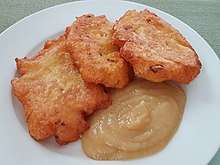 Baggers made of dumpling dough with apple sauce
Baggers made of dumpling dough with apple sauce
Soups
Soups are very popular as starters, but also as main courses. There is often a soup of the day on the menu. Just ask the waitress which soup it is, she will be happy to give you more information.
- Leberknödelsuppe, (liver dumpling soup) is very common. The beef liver is turned by the mincer, the farce is tied with rolls and egg, then formed into dumplings and cooked in broth.
- Brotsuppe, (Bread soup) used to be a leftover meal to use the old, hard bread. This simple dish is very tasty with a good broth and fresh chives.
- A Hochzeitsuppe, (wedding soup) is a broth with various inlays. Popular inlays are a combination of liver dumplings, egg dumplings, semolina dumplings, various vegetables and more. Each inn has its own recipe.
- Bread soup
- Liver dumpling soup
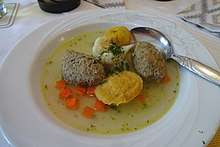 Hochzeitsuppe with liver dumplings, egg stitch, cauliflower and carrots as inlays
Hochzeitsuppe with liver dumplings, egg stitch, cauliflower and carrots as inlays
- In the Hersbruck area there is a culinary speciality for the Kirchweih: the Vogelsuppe, (bird soup). It is traditionally served on the Thursday before a parish fair. However, no birds are used in the soup, which originally comes from the Vogel inn in Pommelsbrunn. The soup consists of heart, kidneys and beef in strips, fried with onions and served with sour sauce and dumplings. Each innkeeper has his own recipe.
Brotzeit
On every menu in taverns there are Brotzeiten in Middle Franconia also called Vesper (elsewhere Jause, Marende etc.). Main ingredients are often homemade sausage and cheese. An important component is the ham, cooked or smoked. A side dish to the snack is bread, preferably home-baked.
- On menus, you'll read mit Musik, (with music) a lot. This means a marinade of vinegar, oil, salt, pepper and onion (no, there's nothing to hear). It is served sausage, press bag, or cheese with the marinade. Where this peculiar name comes from is not known.
- Zwetschgenbames is a speciality of Franconian Switzerland in the Bamberg area. It is made from the lean leg of beef dry salted and develops its full aroma after a maturation period of at least 3 months. It is served finely sliced.
- Geräuchertes (smoked meat) or Schwarzfleisch, (black meat) is the name given to smoked pork ham. It is usually served thinly sliced with pickled gherkin.
- Ausgstraafta, (bratwurst sausage meat), also Bratwurstbrät, Bratwurstmett, Gstrüpfta) are the contents of raw sausages pressed out of the gut and mixed with onions, salt and pepper. They are often eaten as a spread on bread.
- Sülze, (brawn, aspic) is available as brawn in a deep plate as a separate portion or in slices or pieces on a flat plate. Either bread or fried potatoes are served, often with vinegar as a sauce.
- Nürnberger Gwerch is a sausage salad in the greater Nuremberg area. There is no uniform recipe. The basis is the ox mouth salad; the other ingredients vary and are often white and red Pressack (head cheese), Stadtwurst etc.. Served with a vinegar-oil marinade and bread.
- Brotzeitplatte, clockwise from the mustard: Brawn, liver sausage, butter, cucumber, smoked meat, white Pressack (head cheese), Göttinger and red Pressack in the middle.
- Sülze mit Musik
- Nürnberger Gwerch
- Stadtwurst mit Musik
Cheese
- Quärkla, Käsla, Keeszwergla, Kuhkäse are small, flat sour milk cheeses similar to the well-known Harz cheese. They are eaten, seasoned with salt, pepper and caraway seeds, with bread and butter.
- Ziebeleskäs or Weißer Käs is made from curd cheese, usually served with chopped onions.
- Kochkäse, (cook cheese, cancoillotte) is a processed cheese made from low-fat curd cheese and baking soda. It is heated until the curd becomes liquid, stir in butter, egg, salt and caraway seeds and let cool.
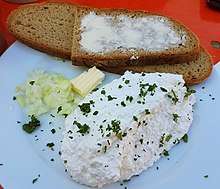 Ziebeleskäs
Ziebeleskäs- Kochkäse
- Limburger or Romandur is called Backstakäs (brick cheese) because the shape of the cheese resembles a brick.
- The Gerupfte consists of "plucked" Camembert and Limburger/Romadur, plus butter, paprika powder and salt. Other possible ingredients are caraway, onion, herbs, spices, cream, milk or beer. The ingredients are processed into a spreadable mass. Bread or pretzels are eaten with it. The Bavarian counterpart is an "Obazda".
- marinated Limburger (mit Musik)
- Ham bread and bread with Limburger
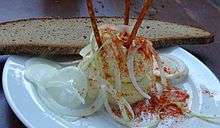 Gerupfter
Gerupfter
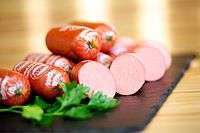
Sausages and meat products
- The Hofer Rindfleischwurst from Hof is a red sausage cold smoked over beech wood. As a "typical regional product with a protected geographical designation of origin", it is a speciality protected throughout Europe.
- Bavarian Leberkäse, (liver cheese) contains no liver, although the name suggests it. Hofer Leberkäse, on the other hand, is basically produced with fresh liver. In the region there is also the one without liver, which is then called Fleischkäse.
- The Ostheimer Leberkäs from Ostheim vor der Rhön is not a Leberkäse in the usual sense, but a baked meat terrine. A butcher brought the idea from France. Muscle and belly meat, pork cheeks and pork liver are ground and seasoned. Before baking, the finished sausage meat is wrapped in a pork net to create a crust with roasted aromas.
- The Franconian Hirnwurst is a smoked cooked sausage made of lean pork, which is eaten with bread and cucumber as a snack.
- Krautwurst consists of pork to which about a third of sauerkraut or cooked white cabbage is added. They are eaten fresh or smoked. In the cabbage season from October to March they are available in butcher's shops and inns in Franconian Switzerland and Steigerwald.
- Stockwurst is only produced by the butchers in Kirchenlamitz in the Fichtelgebirge, the recipe is a few kilometres outside completely unknown. Stockwurst consists of the sausage of beef and pork. It is only cooked in pork casings, not smoked like other sausages. The sausages are eaten fresh. They are only eaten with bread or rolls when they are heated like a white sausage.
- Hausmacher Stadtwurst is a kind of coarse meat sausage. It is available "red", "white" and "black smoked". They are usually eaten cold or warm (red and white, not black) together with sauerkraut and/or mashed potatoes.
- The Nürnberger Stadtwurst is also well known. "Stadtwurst mit Musik" is also common. For many traditional butchers it is a matter of honour to offer a good homemaker. It is said that every Franconian town has its own recipe, a variety almost like the Franconian Bratwurst. There is also the "einfache" Stadtwurst, but that is only the Franconian name for the German-wide common Fleischwurst/Lyoner.
- The Ochsenfurter Peitsche from Ochsenfurt is a long thin sausage. It is made from pork meat and air-dried in natural casings for up to four weeks.
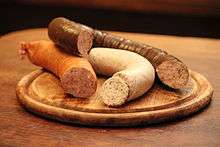 Stadtwurst red, white and black smoked
Stadtwurst red, white and black smoked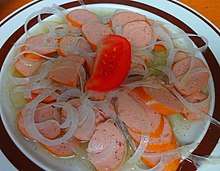 Stadtwurst mit Musik
Stadtwurst mit Musik
Further
- Anisbrezen is a typical Upper Franconian bakery made of wheat flour, caraway, aniseed and salt, which is almost unknown outside the region. They are traditionally only available in winter. In the communities of Weidenberg, Bad Berneck and Creußen there is still the special tradition of the "Brezenwoche". In the period from Epiphany to about Ash Wednesday the innkeepers of the individual villages alternate for a week with a special menu and there is always a basket of pretzels on the table. The locals go to the pretzels to fortify themselves before Lent with hearty food such as Schlachtschüssel, blood and liver sausages, horseradish meat or brawn.
Snack
As in every other German city, there are of course also pizza and kebab to take away in Franconian cities. As in other parts of southern Germany, the Leberkässemmel is also very popular in Franconia, preferably fresh from the butcher.
In almost every pedestrian precinct you will find a permanently built Bratwurststand where the sausages are grilled. But you have to know where you are in Franconia. In Nuremberg it is best to order three bratwursts, further north in the Bayreuth or Kulmbach area you order a pair of bratwursts and even further north in Coburg it is usual to order only one bratwurst.
In Hof you go to the Wärschtlamo, which stands in the pedestrian zone of Hof and keeps Wiener Würstchen, Weißwürste, Knackwürste and Debrecziner warm in its brass sausage kettle with charcoal firing and then sells them to its customers with a roll and mustard.
- Wärschtlamo
- Bratwurststand
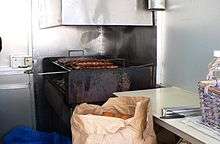 Grill for Coburger Bratwurst
Grill for Coburger Bratwurst
Fish dishes
Franconian carp
Traditionally there are carp in months with a R in the name, from September to April. Mainly served with beer dough baked in fat or in a fish stock as Karpfen blau (carp blue). In the Bamberg area, carp is also served with a hot pepper panade. As side dishes there is often potato salad or a mixed salad plate. In the surroundings of Forchheim the carp is also served sour. The carp cooked in vinegar stock is served with a gingerbread sauce and dumpling.
In Franconia, the high backed 'Spiegelkarpfen is preferred, which can be traced back to the eating habits of the monks in the Middle Ages. In the Middle Ages there were up to 150 days of fasting a year, during which no meat was allowed to be eaten. Furthermore, the food was not allowed to protrude beyond the edge of the plate. This is why the hungry monks of that time bred a carp with a higher back than the long, narrow natural form, so that more fish was on the plate on days of fasting.
- Carp baked in beer batter with price tag, price by weight
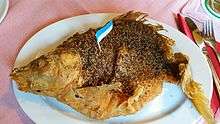 Black pepper is added to the baking dough for pepper carp
Black pepper is added to the baking dough for pepper carp- Carp sour with gingerbread sauce and potato dumpling
- Karpfen blau, mixed salad as side dish
Ingreisch is the roe or sperm (female = Rogner, male = Milchner) or generally the intestines of carp. Today, only roe and milk are usually breaded and baked in fat and served with salad. This dish is mainly found in the Nuremberg area and in the Aischgrund.
The carp fillet is served boneless using a special cutting technique. The fine Y-bones in the fillet are cut through small cuts at a distance of about 5 mm. Thus they are hardly perceptible for the eater and the annoying removal of the bones is void.
- Carp fillet with cut bones, therefore hardly noticeable when eating
- Ingreisch with salad
- hot-smoked, baked and brawned carp
- 🌍 Aischgründer Karpfenmuseum in Neustadt an der Aisch
- 🌍 Landgasthof Hotel zum Stern in Markt Erlbach there are special carp buffets and during the season a large selection of carp dishes. The specialities are carp in many variations up to carp sushi.
- 🌍 Fischküche Reck in Möhrendorf, fish dishes are a focal point of the menu. During the season you can find everything from carp soup to sour fried carp fillet with fried potatoes.
- 🌍 Landgasthof Schrüfer in Pinzberg you will find four carp dishes on the menu, including sour carp with gingerbread sauce and dumpling.
- 🌍 Weberskeller in Höchstadt an der Aisch is the carp is available all year round and in over 30 ways of preparation.
- The Aischgründer Karpfenschmeckerwochen take place every year in September and October. During these weeks the participating inns offer special culinary preparations for the carp.
Meefischli
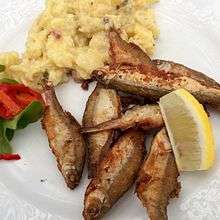
A speciality from Mainfranken. It is a small fried fish from the river Main. Because of their size, the fishes are not gutted (sometimes the head is cut off), rolled in flour and fried. They are available without side dishes or with mixed salad and remoulade. A local Franconian wine is drunk with it.
Meefischli are regularly on the menu here:
- 🌍 Fischerbärbel Restaurant & Café in Veitshöchheim - not in the summer
- 🌍 Cafe Restaurant Sonnenschein also in Veitshöchheim
Trout
They are often offered floated as Forelle Müllerin or cooked in vinegar stock as Forelle Blau with boiled potatoes, melted butter and creamed horseradish. Another variation is the smoked trout, which is eaten lukewarm with horseradish and bread.
- Forelle Müllerin in the brewery inn Rothenbach in Aufsess
- Trout blau with boiled potatoes, melted butter, creamed horseradish and salad
- Trout fillet with creamed radish and mixed salad
Stockfish
In winter and spring and on special days such as Good Friday or Ash Wednesday, stockfish can be found on menus from time to time.
- 🌍 Schwarzes Roß in Presseck the innkeeper buys 150 kg of stockfish in September. From the second Sunday after Michaelis (29 September) until Ash Wednesday, when the purchased quantity lasts that long, the stockfish is served with an onion and bacon cream sauce with dumplings.
- 🌍 Dorfwirtshaus Hildner in Wallenfels there is stockfish from January to April.
- 🌍 Hagleite in Kulmbach there is stockfish on Good Friday, Day of Prayer and Repentance and Ash Wednesday in Altkulmbach style. The stockfish is fried in small pieces with onions and roasted bread slices. A pea purée is served separately as a side dish.
- Stockfish in the old Kulmbacher way
.jpg) Stockfish with onion and bacon cream sauce and dumplings.
Stockfish with onion and bacon cream sauce and dumplings.
Sweets
- Kartäuserklöße, Kadeiserla are rolls soaked in hot milk, turned into sugar crumbs, baked in hot fat and then served with warm vanilla sauce.
- Since the Middle Ages, in Bamberg Süßholz (Licorice) grown. Around the middle of the 20th century the cultivation was almost completely stopped. Since 2010 it has been cultivated again, unique in Germany.
- The Heimatverein of Lichtenau (Middle Franconia) rediscovers the recipe for a historical Christmas biscuit, the Lichtenauer Zucker. Figures made of reddish sugar dough are painted with sugar icing and decorated with wafer pictures. These biscuits were known in the Ansbach area until the post-war period and then fell into oblivion. You can buy the biscuits at the Lichtenauer Adventsmarkt. Whether one nibbles at it, or uses it for decoration, everyone must decide.
- Bamberg licorice
- Das 🌍 Conditorei-Museum in Kitzingen shows the legacy of an old handicraft business with extensive stocks of wooden models, forms of all kinds and other handicraft equipment, in the historical former living rooms. There is also a café in coffee house style.
Lard biscuits
- Küchla, depending on region, shape or filling Kiechla, Kniekiechla, Kiegla, Küchla, Auszogene, Krapfen, Kirchweihkrapfen, Streubele, Sträubla, etc.. It is a lard pastry - a yeast dough that is baked in boiling fat. They are baked at church fairs, carnivals or special occasions such as baptisms, confirmations or weddings.
- Hutkrapfen, are a form of the extended kitchen, which have the form of a hat or also a hood. They are pulled out over a doughnut stick, a turned wooden head. They have been known in the Bamberg region since the 13th century. A distinction is made between large, Catholic and smaller, Protestant Hutkrapfen.
- Kniekiechla
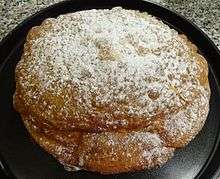 Hutkrapfen
Hutkrapfen
- Dürre Küchla, Flecken, in the Steigerwald they are called Geschnittene Hasen, in the Obermaintal and Coburger Land Harrische, there are many names. The yeast dough is rolled out thinly and then cut into strips. The strips are cut in the middle and then one end is pulled through. The knot is then baked in lard and sprinkled with icing sugar before consumption.
- Schneeballen, (Snowballs) are a lard pastry made from Rothenburg ob der Tauber, which is formed with a special pair of tongs. In the original version they were only sprinkled with icing sugar, meanwhile they are available in various other forms.
- In Kronach there is the Blöchla, an inside hollow lard pastry, which is produced tubularly with a special iron. The blocks are simply sprinkled with icing sugar and eaten mainly during the church fair (Kerwa) season.
- Dürre Küchla, Geschnittene Hasen, Harrische
- Schneeballen
Lebkuchen - gingerbread
Nürnberger Lebkuchen (Nuremberg gingerbread) is a nice souvenir from the Franconian Christmas markets, especially from the Nuremberg Christmas market.
- Nürnberger Lebkuchen is protected by law as a designation of origin. Manufacturers must produce within the city limits of Nuremberg. Gingerbread consists of: Hazelnuts, walnuts and almonds, candied orange peel and lemon peel, honey, flour, sugar and eggs, marzipan and typical spices such as aniseed, ginger, cardamom, coriander, mace, cloves, pimento and cinnamon.
- The Elisenlebkuchen are special Nuremberg gingerbreads with a particularly high-quality composition.
- 🌍 Lebkuchen Schmidt Fabrikverkauf in Nuremberg - The full range of gingerbread products, also 2nd choice. In the visitor hall you can inform yourself.
Outside Nuremberg
- 🌍 Frank Lebkuchen in Arzberg (Upper Franconia) - High-quality Elisen gingerbread on wafers.
- Fichtelgebirgs pumpernickel are longish shaped gingerbread with sugar coating. They have been used in and around Marktredwitz since well before 1800.
- A large selection of gingerbread
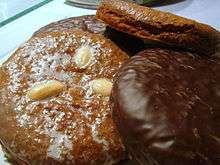 With icing, or chocolate, or pure
With icing, or chocolate, or pure- Tin cans are a popular packaging for gingerbread
- Fichtelgebirgs-Pumpernickel
Other biscuits
- The Bad Kissingen Hörnchen is a butter puff pastry in croissant form with a hazelnut filling. It is probably the result of the fact that in the 19th century, during the spa stay in Bad Kissingen, people did not have breakfast in the hotel in the morning, but had something to eat during the first walk to the medicinal springs.
- Bamberger Hörnla is a pastry similar to a croissant. In Bamberg and its surroundings they are simply called Hörnla and in the rest of Upper Franconia they are called Bamberger. The original is made from a light yeast dough with milk, which has to rest overnight. The next day butter is worked in several layers. The butter content must be at least 20 percent of the flour. The wrapped dough blank is slimmer than the croissant.
- Muskazinen is a pastry that only exists in Dettelbach. It was invented especially for pilgrims and is seasoned with cinnamon, cloves and nutmeg.
- Kitzinger Kätherle is a dry savoury pastry to accompany wine.
- 🌍 Bäckerei Eichinger in Prichsenstadt
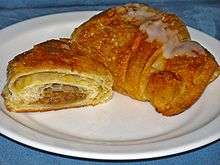 Kissinger Hörnchen
Kissinger Hörnchen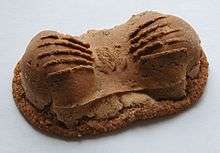 Muskazine
Muskazine
- Großenhül is a district of Wonsees. Here the 🌍 Blechkuchenfest takes place at the end of August. On Sunday afternoon there are about 100 different cakes from the baking tray.
Pralines
- 🌍 Frankenwald Confiserie & Café Bauer, Orlamünder Straße 39, 96337 Ludwigsstadt-Lauenstein, ☎ +49 9263 215, e-mail: info@c-bauer.de. Mon - Fri 8:00 - 18:00; Sat, Sun & Holiday 13:00 - 18:00. (Lauensteiner) Chocolate specialities and cream puffs.
- 🌍 Werksverkauf Esther Pralinen, Grafendobrach 5, 95326 Kulmbach, ☎ +49 9223 742. Mon to Fri 9.00-17.00. Special chocolates, such as the Kulmbach beer truffles, are available in the Grafendobrach district. In Kulmbach they are sold at Marktplatz 12, Tel. +49 9221 6058486.
- Pralines at Confiserie Bauer
Beverages
Franconia can be roughly divided into beer and wine Franconia. In the west, in Lower Franconia, and in parts of Upper Franconia, more is attributed to wine, in the eastern part of Upper Franconia and in Middle Franconia, on the other hand, more beer is drunk.
Wine
Franconian wines are usually "dry" vinified. Dry wines may only contain half as much residual sugar (4 instead of 9 grams per litre) as wines from other German wine regions. The Bocksbeutel is the typical bottle shape and is often used for higher quality Franconian wines.
- The Silvaner vine is the most typical Franconian grape variety and is one of the oldest vines still cultivated today. The Silvaner probably arrived in Germany in the 17th century from the Danube region. It was first verifiably planted in Castell in Germany in 1659. A few years later, in 1665, Alberich Degen, the abbot of Kloster Ebrach, planted a Silvaner vine in the "Würzburger Stein" vineyard for the first time.
- Müller-Thurgau also called Rivaner after the presumed parent vines Riesling and Silvaner, is the most common grape variety in the Franconian wine-growing regions.
- The term Bremser or Sturm is used to describe the grape must that has just begun to ferment and is still sweet. If it becomes more acidic and contains more alcohol, it is then called Federweißer as in the rest of Germany. The serving is limited to a few weeks of the year in autumn.
- The Rotling is not to be confused with the rosé, the way it is made is fundamentally different. In the Rotling, white and red grapes are fermented together and not the wines mixed, or like in the Rosé, the juice of red grapes pressed.
- A speciality is the red wine grape variety Tauberschwarz, which is cultivated as an old native variety only in the Tauber- and Vorbachtal (and in the adjoining Lower Franconia). The grape produces light, fruity red wines. As a grape variety typical of the region, it has been included in the Ark of Taste by Slow Food.
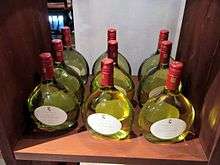 Bocksbeutel with Franconian wine
Bocksbeutel with Franconian wine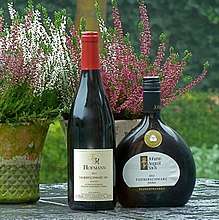 Tauberschwarz, matured on oak, or young in a Bocksbeutel bottled
Tauberschwarz, matured on oak, or young in a Bocksbeutel bottled
Beer
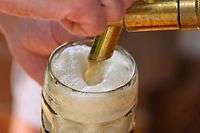
- See also: Breweries in Franconia
A Seidla is in Franconia a beer mug or beer glass with half a litre.
The expression ungespundetes Bier, (unspun beer) comes from the so-called Spundloch, (bunghole) at the beer barrel. In wooden barrels, this hole on the top serves to equalize the pressure during fermentation, where carbonic acid and thus excess pressure is created. The unspun beer, which is mainly used in Franconia, ferments without closing this hole and thus has a lower carbonic acid content than other beers.
Kellerbier, also called Zwickelbier or Zwickl, is an unfiltered, naturally cloudy beer which still contains all suspended and turbid substances. It belongs to the group of unspun, low carbonated beers, has a short shelf life and should always be drunk fresh.
Many breweries offer a strong beer at certain times of the year, also called "Bockbier", which often ends in "-ator", e.g. Markator (Schinner, Bayreuth) or Mobilator (Gottmannsgrüner Brauerei). The bock beer tapping is usually duly celebrated in the brewery restaurants.
- In Pegnitz the strong beer season is from April to the beginning of July. Every week the Flinderer, as the strong beer is called, is served in various restaurants.
Mischgetränke
- Ein Radler ist eine Mischung aus Bier und Zitronenlimonade. In Brauereien wird man häufig gefragt, ob mit hellem oder dunklem Bier gemischt werden soll. In anderen Gegenden (vor allem Norddeutschland) wird es Alsterwasser genannt.
- Ein Russe ist eine Mischung aus Weizenbier und Zitronenlimonade.
- In Oberfranken wird sie Gaaß-Maß, in Mittelfranken Bumber (Bumbers/Bumb)-Maß oder -seidla genannt. Dabei handelt es sich um ein Biermischgetränk aus hellem oder dunklem Bier oder Weißbier, Cola und Kirschlikör oder Cognac. Regional unterscheiden sich die Rezepte sowie die Aussprache. Gelegentlich wird auch Kirschlikör und Cognac gleichzeitig benutzt.
Spirits
Whisky
- The Blaue Maus Whisky Distillery in Eggolsheim is Germany's oldest single malt whisky distillery. For over 30 years, whiskies have been distilled from local malts, which are stored in oak barrels for 6-8 years until they are ready for consumption.
- Rhön whisky from the Bischof distillery in Wartmannsroth
- Franconian Whisky of the Mößlein Winery in Zeilitzheim
Liqueurs
- The well-known Sechsämtertropfen (similar to Jägermeister) come from the Sechsämterland in the middle of the Fichtelgebirge. The production of the liqueur can be seen in Wunsiedel.
- Liqueur lovers are recommended to visit the Alte Kurhausbrennerei Hans Hertlein in Wiesenttal/Streitberg in Franconian Switzerland to try a 'Streitberger Bitter.
Fruit brandies
In southern Franconian Switzerland, the landscape is still characterised by many orchard meadows. The fruit of the old trees is mashing and then distilled, excellent 'fruit brandies are created, which can be tasted and bought in the many small distilleries.
- 🌍 Edelbrennerei Haas in Pretzfeld. The assortment includes more than 40 different distillates as well as fruit wines and liqueurs. The speciality are wild fruit brandies.
Ingredients
Meerrettich or Kren - horseradish
Horseradish is an important ingredient in Franconian cuisine. It is particularly appreciated for "Krenfleisch" (cooked meat with horseradish sauce), but is also eaten freshly grated with coarse fried sausages.
- Meerrettich - Museum Baiersdorf, in Baiersdorf.
- Every year on the 3rd Sunday in September the traditional Baiersdorfer Krenmarkt takes place in Baiersdorf.
- Kochs Meerrettich Fabrikverkauf, in Baiersdorf.
Potatoes
Bamberger Hörnla. are one of the oldest German potato varieties, officially registered in Franconia since 1854, not to be confused with the traditional yeast pastry of the same name. The potatoes are small and have a crooked, elongated shape. Since they are firm, they are particularly suitable for potato salad. The potato variety can be bought at weekly markets and in shops with local products, in supermarkets or outside Franconia they are difficult to find..
- 🌍 Erlebnisernte Hofladen, Eichenhof 1b, 96175 Pettstadt. Tuesday to Friday 9.30-18.00 , Saturday 8.00-16.00 , Sunday Café 13.00-17.00.
Asparagus
Asparagus is cultivated in all Franconian districts, with a focus on Lower and Middle Franconia. Asparagus is often eaten with fried sausages and potatoes, but you will also find other varieties on the menus. In 2013, the European Commission included Franconian asparagus in the EU quality register of products with a protected geographical indication (PGI).
If possible, you should buy fresh asparagus from the grower; long transport does not make it any better. If the cut ends are not dried out and the asparagus spears squeal when you rub them together, then it is fresh. With some asparagus farmers, the spears can be peeled immediately.
The white asparagus has only grown underground and has not seen any sunlight. The green asparagus was harvested above ground.
- Asparagus as a side dish
- Typical Franconian, asparagus with Bratwursts
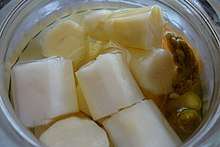 Asparagus pickled
Asparagus pickled
Depending on the soil temperature, the asparagus season runs from mid-April to St John's Day on 24 June, after which the asparagus may grow to gather strength for harvesting next year. Today, asparagus fields are covered with black plastic foil to accelerate the heating of the soil in spring, so that the first stalks can be pricked earlier.
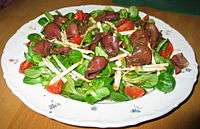
Hop sprouts
Hops are grown south of Nuremberg around the towns of Spalt and Roth. The hop sprouts, which are also called hop asparagus, are the surplus shoots of the hop plant. Only three shoots allow the hop growers to twine up on the wires, the remaining shoots were broken off earlier and thrown away. Today they are used as seasonal vegetables in the kitchen. Every year, depending on the weather between mid-March and the end of April, there are fewer restaurants in the area for about three weeks of hop sprouts on the menus. There are many ways to use hop sprouts in the kitchen, as soup, as hop sprouts salad, with ham in beer dough, with Franconian sausages, or sautéed as a side dish with meat.
Miscellaneous
- The Landschaftspflegeverband in 🌍 Weidenberg is committed to the preservation of ecologically valuable orchards in the region. In order to protect the orchards, the apples are used and the following products are offered: apple-secco, apple-elder-secco, apple-elder jelly, spindling jam (a yellow plum from the area) and schnapps and liqueurs from local fruit. The products are sold in the Weidenberg area as far as Creußen.
- In the village of walnuts 🌍 Sammenheim a part of the village Dittenheim everything revolves around walnuts and products that can be made from them. In the village, green and ripe nuts are processed into regional delicacies, such as walnut liqueurs and sweet and sour pickled walnuts. The nut market takes place at the beginning of September, with walnut bread, nut roll roasts, nut sausages and nut cakes. The products, such as walnut oil or walnut mash, are sold through the cooperative Gelbe Bürg at various points of sale in the area.
Culinary Calendar
Culinary delights are often seasonal. Fruit and vegetables are tastier when they are harvested ripe. Meat and fish are also subject to seasonal influences. At any time of the year, festivities are celebrated that focus on enjoyment in general or on certain foods in particular. There are also drinking and eating habits in the course of the year, which have arisen from religious traditions such as Lent.
January
- Carp time
- In the communities Weidenberg, Bad Berneck and Creußen there are the Brezenwochen, see above.
February
- Carp time
- In the communities Weidenberg, Bad Berneck and Creußen there are the Brezenwochen, see above.
March
- Carp time
- In the communities Weidenberg, Bad Berneck and Creußen there are the Brezenwochen, see above.
- On the second weekend the Feinschmeckermesse takes place in Iphofen, alternating annually with the Iphöfer Weinfreundschaften (odd years). The gourmet fair offers new products and local delicacies. The wine friendships are all about wine, also with participants from other wine-growing regions.
April
- Carp time
- In the Frankenwald there is the action Spring awakening with the Franconian Forest kid, a series restaurateurs revive a regional tradition and serve goat meat.
- The asparagus season begins at the beginning of April and lasts until mid-April, depending on the soil temperature.
- Traditionally the Day of Beer is celebrated on April 23rd, because on this day in 1516 the German Purity Law was proclaimed. In many places there are events about beer (Deutscher Brauer Bund).
May
- Spargelsaison
- The Weindorf is a culinary wine festival at the market place in Würzburg. It lasts 10 days from the last Friday in May.
- In Pegnitz the "Bratwurst summit" takes place on the Sunday before Whitsun. Butchers compete for the best Bratwurst in the categories classic and creative.
- At the end of May the Franconian Beer Festival is held in Nuremberg. 40 privately run breweries present over 100 different types of beer. There is live music and a wide culinary offer.
- From May to 24 June, Espargo festivals take place in the area Schweinfurt, farmers, winegrowers and innkeepers invite you to wine and asparagus events.
June
- From May to 24 June, Espargo festivals take place in the area Schweinfurt, farmers, winegrowers and innkeepers invite you to wine and asparagus events.
- The asparagus season ends on St John's Day, 24 June.
July
- The Bio-Fest Bio erleben takes place in mid-July on the Hauptmarkt in Nuremberg.
- Cherry Festival in Pretzfeld, third weekend in July
August
- A weekend at the end of August is in Coburg Dumpling market. Everything revolves around the Coburg Dumpling. There are various roasts to the dumplings, such as sour and pork roast and roulades with the appropriate sauces
- On the 4th weekend in August, hundreds of portions of horseradish meat and dumplings will be eaten at the Zeltkerwa in the Eckersdorf district of Neustädtlein on Thursday afternoon.
- On a Sunday afternoon at the end of August Blechkuchenfest is the festival of flat cakes in Wonsees in the district of Großenhül.
September
- Carp time
- At the beginning of September the "Nut Market" takes place in Sammenheim (see above).
- From the beginning of September to the beginning of November 20 landlords organise the Aischgrund Carp Tasting Weeks
- Scharfen Wochen, in October gastronomes in [Franconian Switzerland] regularly offer their own menu with at least three horseradish main courses.
- Every year on the 3rd Sunday in September the traditional Baiersdorf horseradish market takes place in the town of Baiersdorf.
- On the 3rd Sunday in September the Heglauer Krautfest is celebrated in Merkendorf (Middle Franconia). There are cabbage plane demonstrations, free sauerkraut samples, cabbage head treasures and culinary cabbage specialities such as cabbage rolls, cabbage soup, cabbage ice cream, cabbage cheese, cabbage pralines and cabbage cake.
- Bremser or Sturm is the name given to fermenting wine. The serving in Mainfranken is limited to a few weeks in autumn.
October
- Carp time
- Bremser or Sturm is the name given to fermenting wine. The serving in Mainfranken is limited to a few weeks in autumn.
- From the beginning of September to the beginning of November 20 innkeepers organise the Aischgrund Carp Tasting Weeks
- On the first weekend of October, the traditional pumpkin festival is held in Altendorf (Bamberg district). Pumpkin dishes are offered, from soup to special pumpkin bratwurst.
- The Rhön sausage market in front of the town hall in Ostheim vor der Rhön is the culinary highlight of the region with up to 25 0000 visitors.
- The Day of open distilleries and breweries is every year around the mountain Walberla on the third Sunday in October
- "Bock beer tapping" at many of the breweries in the Bamberg area
- On the third Sunday the "Allerweltskirchweih" is celebrated in many villages.
- The last week in October is Fischerntewoche (fish harvest week) in Dinkelsbühl
- The purchasing fair Consumenta takes place in Nuremberg at the end of October. Culinary delights ranging from down-to-earth to upscale gastronomy are offered.
November
- Carp time
- Around St. Martin's Day on 11 November, many inns offer ganja dishes as a traditional St. Martin's goose meal.
- "Bock beer tapping" at many of the breweries in the Bamberg area
December
- Carp time
- Bockbier-Anstiche bei vielen der Brauereien im Raum Bamberg
- On the first Advent-weekend the gingerbread market takes place from Friday to Sunday, at Maxplatz in Rehau. Not only gingerbread, but also gingerbread liqueur, gingerbread mulled wine, gingerbread sausages, chocolates and sweets, such as stollen, cinnamon stars, butter cookies and pyramid cake.
Museums
- 🌍 Herb and Spice Museum Kaulfuss in downwind. The private spice museum is housed in a 450 year old barn, on 1000 square meters, on four floors.
- 🌍 Horseradish Museum in Baiersdorf. Everything about horseradish.
- 🌍 Conditorei-Museum in Kitzingen. The legacy of an old handicraft business with extensive stocks of wooden models, forms of all kinds and other handicraft equipment, in the historical former living rooms. In addition there is a café in the coffee house style with 60 seats.
Literature
- Original Fränkisch - The Best of Franconian Food, Hädecke Verlag, 2014, ISBN=978-3775006620, english and german
Weblinks
- genussregion.oberfranken.de - The association (tourism, public and food handicraft) informs about specialities of the pleasure region Upper Franconia.
- spezialitaetenland-bayern.de - Information on Bavarian specialties from the Bavarian State Ministry of Food, Agriculture and Forestry
- 100genussorte.bayern - the State Institute for Viticulture and Horticulture presents 100 places with local specialities.